-
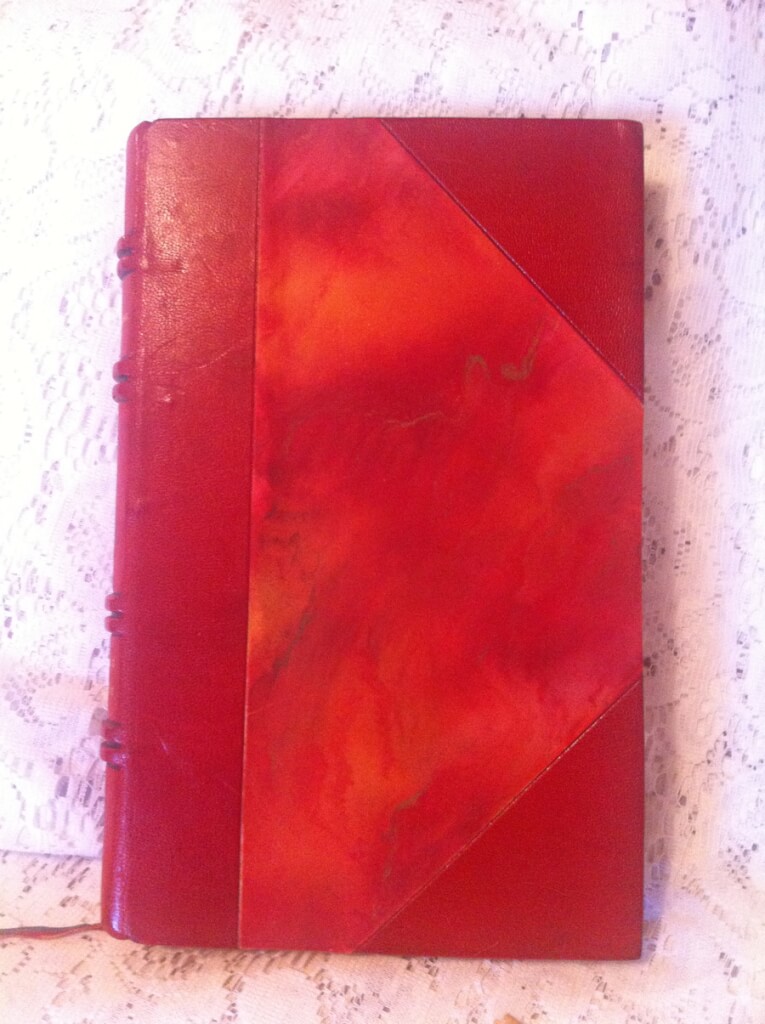
 Manuel D'Érotologie Classique (de figuris Veneris) by Fred. Chas. Forberg, trans. Alcide Bonneau (Imprimé pour René Bonnel, Paris, 1933, #123/500) 6" x 9.25", 223pp, three quarter red leather, gilt titles on spine, 4 raised double bands, near fine condition, ribbon intact, hand-laid Arches paper (identifying watermarks), original paper covers bound in. Rene Bonnel, the publisher of this edition, was one of the foremost publishers of finely printed illegal erotica in the 1930's. This work was openly published and is no exception to the quality of his books. De figuris Veneris (On the figures of Venus) was an anthology of ancient Greek and ancient Roman writings on erotic topics, discussed objectively and classified and grouped by subject matter. (I. Of Copulation, II. Of Pederastia, III. Of Irrumation, IV. Of Masturbation, V. Of Cunnilingues, VI. Of Tribads, VII. Of Intercourse with Animals, VIII. Of Spintrian Postures) It was first published by the German classicist Friedrich Karl Forberg in 1824 in Latin and Greek as “Antonii Panormitae Hermaphroditus”, an erotic poem sequence in renaissance Latin. Forberg later reprinted it as “Manuel D’Érotologie Classique (de figuris Veneris)”. It was translated into English (published by Charles Carrington in 1899 and again by Charles Hirsch in 1907), French and German (one French edition was illustrated by Édouard-Henri Avril [Paul Avril]). It concludes with a list of 95 sexual positions. In 1899 Forberg's work was translated into English and published by Charles Carrington as De figuris Veneris, Manual of classical erotology, and again in 1907 by Charles Hirsch, and into French, German and Spanish. The French edition by Alcide Bonneau was titled Manuel d’érotologie classique. One French edition of 1906 was illustrated by Édouard-Henri Avril, which concludes with a list of 95 sexual positions. Most of the editions were restricted to high society or censored; one of the copies edited in France was immediately deposited on the secret shelves of the Bibliothèque nationale de France.
Manuel D'Érotologie Classique (de figuris Veneris) by Fred. Chas. Forberg, trans. Alcide Bonneau (Imprimé pour René Bonnel, Paris, 1933, #123/500) 6" x 9.25", 223pp, three quarter red leather, gilt titles on spine, 4 raised double bands, near fine condition, ribbon intact, hand-laid Arches paper (identifying watermarks), original paper covers bound in. Rene Bonnel, the publisher of this edition, was one of the foremost publishers of finely printed illegal erotica in the 1930's. This work was openly published and is no exception to the quality of his books. De figuris Veneris (On the figures of Venus) was an anthology of ancient Greek and ancient Roman writings on erotic topics, discussed objectively and classified and grouped by subject matter. (I. Of Copulation, II. Of Pederastia, III. Of Irrumation, IV. Of Masturbation, V. Of Cunnilingues, VI. Of Tribads, VII. Of Intercourse with Animals, VIII. Of Spintrian Postures) It was first published by the German classicist Friedrich Karl Forberg in 1824 in Latin and Greek as “Antonii Panormitae Hermaphroditus”, an erotic poem sequence in renaissance Latin. Forberg later reprinted it as “Manuel D’Érotologie Classique (de figuris Veneris)”. It was translated into English (published by Charles Carrington in 1899 and again by Charles Hirsch in 1907), French and German (one French edition was illustrated by Édouard-Henri Avril [Paul Avril]). It concludes with a list of 95 sexual positions. In 1899 Forberg's work was translated into English and published by Charles Carrington as De figuris Veneris, Manual of classical erotology, and again in 1907 by Charles Hirsch, and into French, German and Spanish. The French edition by Alcide Bonneau was titled Manuel d’érotologie classique. One French edition of 1906 was illustrated by Édouard-Henri Avril, which concludes with a list of 95 sexual positions. Most of the editions were restricted to high society or censored; one of the copies edited in France was immediately deposited on the secret shelves of the Bibliothèque nationale de France. -

 Les métamorphoses ou l'asne d'or de Luce Apulée philosophe platonique, Lucius Apuleius Madaurensis (124-170 AD), trans. Jules De Marthold, illust. [21 etchings] Martin van Maele (Charles Carrington, Librairie-Éditeur, 1905, Paris, #88/750) 9.25" X 6.25", xlviii+328pp., original soft wraps protected by glassine wraps, Chapter pieces in orange and black, tail pieces in black, large, decorative first letter of each chapter, frontispiece + 21 full-page b/w engravings with tissue guards and numerous in-text illustrations by Martin van Maele, very good condition for age. The Metamorphoses of Apuleius, which St. Augustine referred to as "The Golden Ass", is the only Ancient Roman novel in Latin to survive in its entirety. The plot Lucius and his curiosity and insatiable desire to see and practice magic. While trying to perform a spell to transform into a bird, he is accidentally transformed into an ass. This leads to a long journey, literal and metaphorical, filled with in-set tales. He finally finds salvation through the intervention of the goddess Isis, whose cult he joins. The date of the original work is uncertain. Scholars are not sure if he wrote it in his youth or at the end of his life. He adapted the story from a Greek story written by Lucius of Patrae, however his original Greek text has long been lost. Maurice François Alfred Martin van Miële (1863-5 - 1926), better known by his pseudonym Martin van Maële, was a French illustrator of early 20th century literature. Though he gained notoriety with his illustration for H. G. Wells in Les Premiers Hommes dans la Lune, and he worked as an illustrator for the Félix Juven's French translations of the Sherlock Holmes series, he is now most widely renowned and mostly remembered for his erotic illustrations. This is a beautiful and rare book in it's original paper wraps.
Les métamorphoses ou l'asne d'or de Luce Apulée philosophe platonique, Lucius Apuleius Madaurensis (124-170 AD), trans. Jules De Marthold, illust. [21 etchings] Martin van Maele (Charles Carrington, Librairie-Éditeur, 1905, Paris, #88/750) 9.25" X 6.25", xlviii+328pp., original soft wraps protected by glassine wraps, Chapter pieces in orange and black, tail pieces in black, large, decorative first letter of each chapter, frontispiece + 21 full-page b/w engravings with tissue guards and numerous in-text illustrations by Martin van Maele, very good condition for age. The Metamorphoses of Apuleius, which St. Augustine referred to as "The Golden Ass", is the only Ancient Roman novel in Latin to survive in its entirety. The plot Lucius and his curiosity and insatiable desire to see and practice magic. While trying to perform a spell to transform into a bird, he is accidentally transformed into an ass. This leads to a long journey, literal and metaphorical, filled with in-set tales. He finally finds salvation through the intervention of the goddess Isis, whose cult he joins. The date of the original work is uncertain. Scholars are not sure if he wrote it in his youth or at the end of his life. He adapted the story from a Greek story written by Lucius of Patrae, however his original Greek text has long been lost. Maurice François Alfred Martin van Miële (1863-5 - 1926), better known by his pseudonym Martin van Maële, was a French illustrator of early 20th century literature. Though he gained notoriety with his illustration for H. G. Wells in Les Premiers Hommes dans la Lune, and he worked as an illustrator for the Félix Juven's French translations of the Sherlock Holmes series, he is now most widely renowned and mostly remembered for his erotic illustrations. This is a beautiful and rare book in it's original paper wraps. -

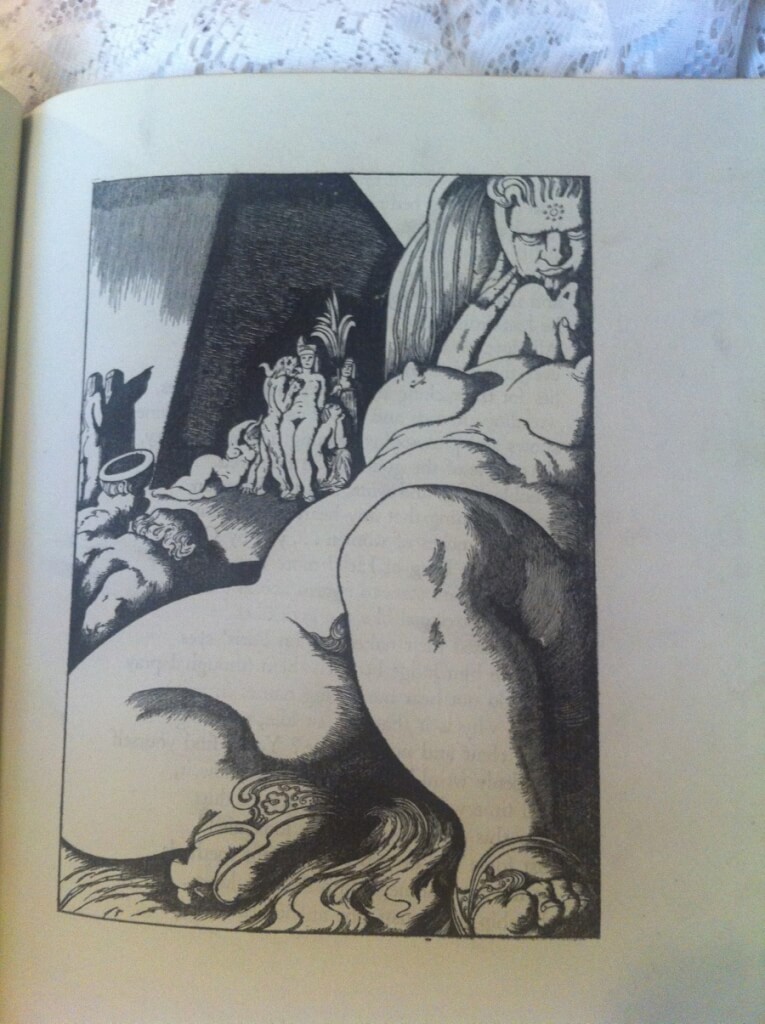 The Mimiambs of Herondas, Herodas, Translated by Jack Lindsay, Decorated by Alan Odle, with a Foreword by Brian Penton. (The Fanfrolico Press, London, nd [c. 1929], #351/375 [first edition, and first Fanfrolico to be printed in London]) 11 7/8" X 9 3/8", unpaginated 72pp, hardbound no DJ, original buckram-backed decorated Japanese paper boards with plain green cloth spine and gilt lettering, top edge gilt, other edges deckle, poor condition, boards show major wear, spine worn off, binding still good, boards still attached, interior pages are fine, Cloister types on Van Gelder Antique handmade paper Herodas was a Greek poet and the author of short humorous dramatic scenes in verse, written under the Alexandrian empire in the 3rd century BC. Mimes were scenes in popular life in South Italy and Sicily, written in the language of the people, vigorous with racy proverbs such as we get in other reflections of that region. The Mimes of Herodas have been known to us only since the discovery and publication of the "Kenyon", M. S. Buck, by the British Museum in 1891 (from a parchment containing 7 legible mimes half of the 8th and a fragment of the 9th). This was Fanfrolico's first London book. It was published "for subscribers to The Franfrolico Press". This new translation of Mimiambs of Herondas was translated by Jack Lindsay and beautifully illustrated by Alan Odle whose grotesque and subversive style was a precursor of surrealism. This is a beautiful printed book in great condition and quite rare. Fanfrolico Press, Australia’s first ‘private press’ in the arts-and-craft tradition, was founded by Jack Lindsay, P. R. Stephensen and John Kirtley, originally in North Sydney in 1923. The press specialized in printings artful, limited editions of classics and forgotten works that were suited to the extravagant style of artist like his father, artist, sculptor and author Norman Lindsay who illustrated many of their books. Fanfrolico was scornful of modernism and with its florid style determinedly backward-looking. They did surprisingly well, despite the lack of business expertise of their young, ambitious "bohemian" owners, eking out a living despite the risky move to London in 1926 and upheavals in ownership that saw the departure in 1927 of Kirtley, and then Stephenson in 1929. Sometime in 1930 they published their last book.
The Mimiambs of Herondas, Herodas, Translated by Jack Lindsay, Decorated by Alan Odle, with a Foreword by Brian Penton. (The Fanfrolico Press, London, nd [c. 1929], #351/375 [first edition, and first Fanfrolico to be printed in London]) 11 7/8" X 9 3/8", unpaginated 72pp, hardbound no DJ, original buckram-backed decorated Japanese paper boards with plain green cloth spine and gilt lettering, top edge gilt, other edges deckle, poor condition, boards show major wear, spine worn off, binding still good, boards still attached, interior pages are fine, Cloister types on Van Gelder Antique handmade paper Herodas was a Greek poet and the author of short humorous dramatic scenes in verse, written under the Alexandrian empire in the 3rd century BC. Mimes were scenes in popular life in South Italy and Sicily, written in the language of the people, vigorous with racy proverbs such as we get in other reflections of that region. The Mimes of Herodas have been known to us only since the discovery and publication of the "Kenyon", M. S. Buck, by the British Museum in 1891 (from a parchment containing 7 legible mimes half of the 8th and a fragment of the 9th). This was Fanfrolico's first London book. It was published "for subscribers to The Franfrolico Press". This new translation of Mimiambs of Herondas was translated by Jack Lindsay and beautifully illustrated by Alan Odle whose grotesque and subversive style was a precursor of surrealism. This is a beautiful printed book in great condition and quite rare. Fanfrolico Press, Australia’s first ‘private press’ in the arts-and-craft tradition, was founded by Jack Lindsay, P. R. Stephensen and John Kirtley, originally in North Sydney in 1923. The press specialized in printings artful, limited editions of classics and forgotten works that were suited to the extravagant style of artist like his father, artist, sculptor and author Norman Lindsay who illustrated many of their books. Fanfrolico was scornful of modernism and with its florid style determinedly backward-looking. They did surprisingly well, despite the lack of business expertise of their young, ambitious "bohemian" owners, eking out a living despite the risky move to London in 1926 and upheavals in ownership that saw the departure in 1927 of Kirtley, and then Stephenson in 1929. Sometime in 1930 they published their last book. -
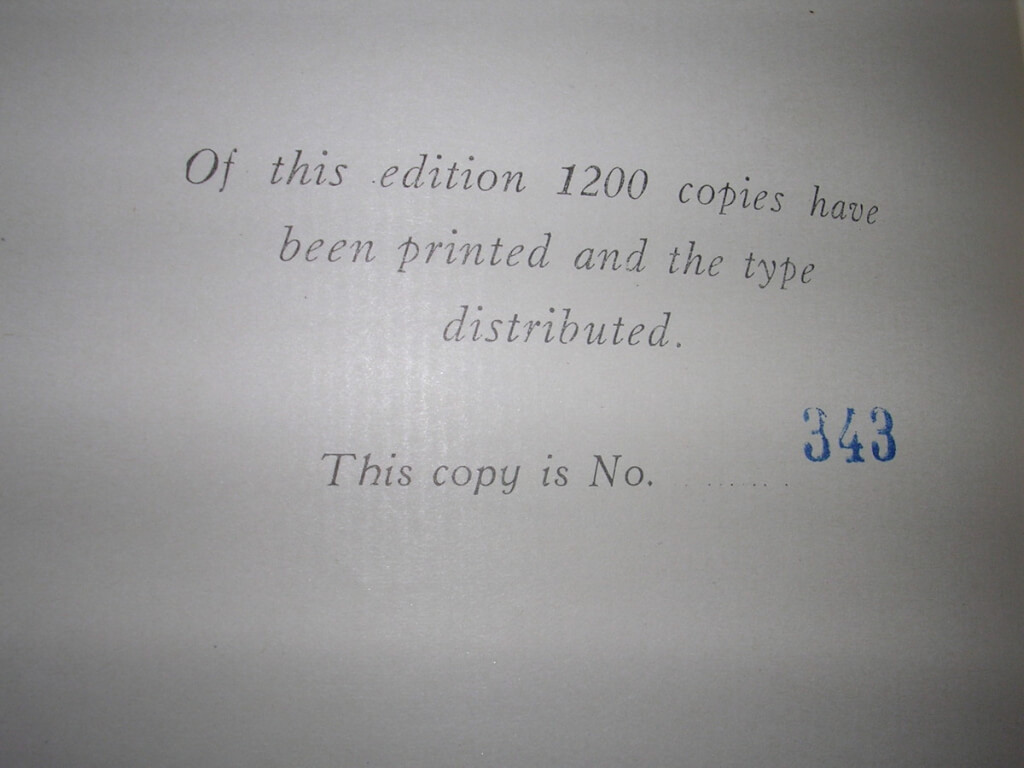
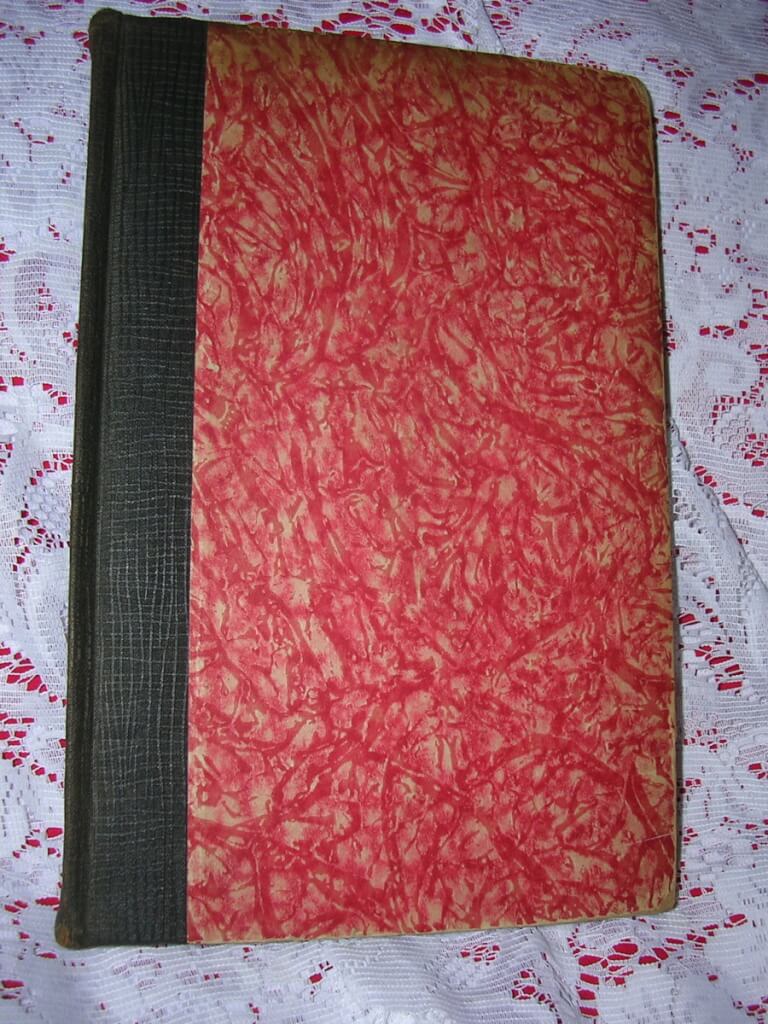 The Satyricon of Petronius Arbiter, Gaius Petronius, trans. ascribed to Oscar Wilde (Privately Printed, 1928, Limited Edition 343/1200 stamped in ink) 9" X 6 1/4", 236pp, black spine with gilt titles (mostly worn off), decorated red boards. Fair copy, boards worn, binding good. Front board loose but holding. Satyricon (or Satyrica) is a Latin work of fiction in a mixture of prose and poetry (prosimetrum). It is believed to have been written by Gaius Petronius, though the manuscript tradition identifies the author as a certain Titus Petronius. Classical scholars often describe it as a "Roman novel", without necessarily implying continuity with the modern literary form. The surviving portions of the text detail the misadventures of the narrator, Encolpius, and his lover, a handsome sixteen-year-old boy named Giton. Throughout the novel, Encolpius has a hard time keeping his lover faithful to him as he is constantly being enticed away by others. Encolpius's friend Ascyltus (who seems to have previously been in a relationship with Encolpius) is another major character. It is a rare example of a Roman novel, the only other surviving example (quite different in style and plot) being Metamorphoses of Apuleius. It is also extremely important evidence for the reconstruction of what everyday life must have been like for the lower classes during the early Roman Empire.
The Satyricon of Petronius Arbiter, Gaius Petronius, trans. ascribed to Oscar Wilde (Privately Printed, 1928, Limited Edition 343/1200 stamped in ink) 9" X 6 1/4", 236pp, black spine with gilt titles (mostly worn off), decorated red boards. Fair copy, boards worn, binding good. Front board loose but holding. Satyricon (or Satyrica) is a Latin work of fiction in a mixture of prose and poetry (prosimetrum). It is believed to have been written by Gaius Petronius, though the manuscript tradition identifies the author as a certain Titus Petronius. Classical scholars often describe it as a "Roman novel", without necessarily implying continuity with the modern literary form. The surviving portions of the text detail the misadventures of the narrator, Encolpius, and his lover, a handsome sixteen-year-old boy named Giton. Throughout the novel, Encolpius has a hard time keeping his lover faithful to him as he is constantly being enticed away by others. Encolpius's friend Ascyltus (who seems to have previously been in a relationship with Encolpius) is another major character. It is a rare example of a Roman novel, the only other surviving example (quite different in style and plot) being Metamorphoses of Apuleius. It is also extremely important evidence for the reconstruction of what everyday life must have been like for the lower classes during the early Roman Empire. -

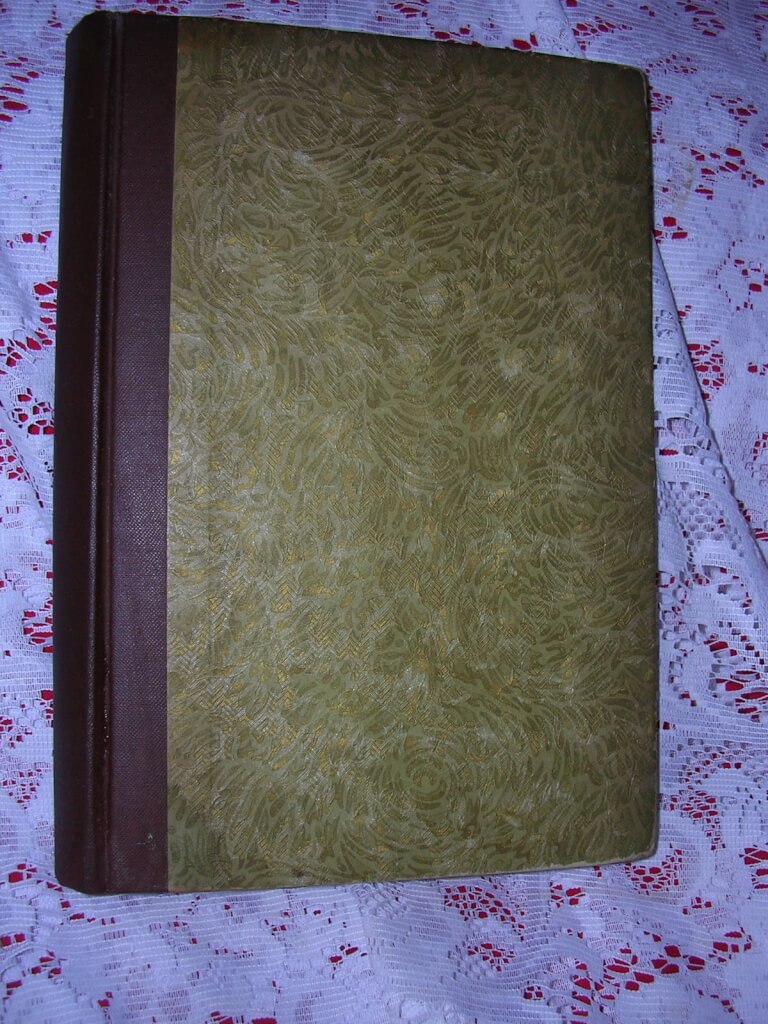 The Satyricon of Petronius Arbiter, Gaius Petronius, trans. ascribed to Oscar Wilde (Privately Printed, 1928, Limited Edition of 1200 unnumberd) 9" X 6 1/4", 236pp, Brown spine with gilt titles (mostly worn off), decorated boards with green and gilt. Deckle bottom and fore edges, top edge inked purple. Fair copy, spine cocked, binding and boards good, corners worn. Satyricon (or Satyrica) is a Latin work of fiction in a mixture of prose and poetry (prosimetrum). It is believed to have been written by Gaius Petronius, though the manuscript tradition identifies the author as a certain Titus Petronius. Classical scholars often describe it as a "Roman novel", without necessarily implying continuity with the modern literary form. The surviving portions of the text detail the misadventures of the narrator, Encolpius, and his lover, a handsome sixteen-year-old boy named Giton. Throughout the novel, Encolpius has a hard time keeping his lover faithful to him as he is constantly being enticed away by others. Encolpius's friend Ascyltus (who seems to have previously been in a relationship with Encolpius) is another major character. It is a rare example of a Roman novel, the only other surviving example (quite different in style and plot) being Metamorphoses of Apuleius. It is also extremely important evidence for the reconstruction of what everyday life must have been like for the lower classes during the early Roman Empire.
The Satyricon of Petronius Arbiter, Gaius Petronius, trans. ascribed to Oscar Wilde (Privately Printed, 1928, Limited Edition of 1200 unnumberd) 9" X 6 1/4", 236pp, Brown spine with gilt titles (mostly worn off), decorated boards with green and gilt. Deckle bottom and fore edges, top edge inked purple. Fair copy, spine cocked, binding and boards good, corners worn. Satyricon (or Satyrica) is a Latin work of fiction in a mixture of prose and poetry (prosimetrum). It is believed to have been written by Gaius Petronius, though the manuscript tradition identifies the author as a certain Titus Petronius. Classical scholars often describe it as a "Roman novel", without necessarily implying continuity with the modern literary form. The surviving portions of the text detail the misadventures of the narrator, Encolpius, and his lover, a handsome sixteen-year-old boy named Giton. Throughout the novel, Encolpius has a hard time keeping his lover faithful to him as he is constantly being enticed away by others. Encolpius's friend Ascyltus (who seems to have previously been in a relationship with Encolpius) is another major character. It is a rare example of a Roman novel, the only other surviving example (quite different in style and plot) being Metamorphoses of Apuleius. It is also extremely important evidence for the reconstruction of what everyday life must have been like for the lower classes during the early Roman Empire. -

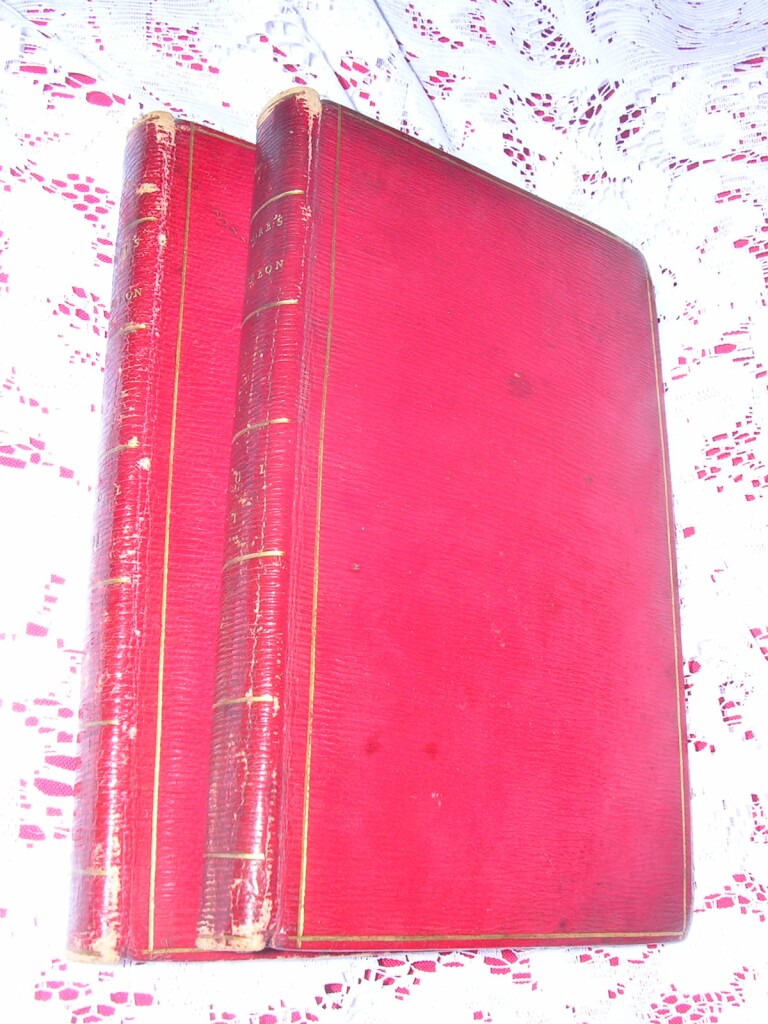 Odes of Anacreon, Anacreon, trans. Thomas Moore (J. and T. Carpenter, London, 1802) 6 1/2" X 4 1/4", 2 vol. 163pp 148pp, hardbound in red morocco with gilt lettering and decorations, gilted edges, marbled boards, worn edges and corners befitting it's age, binding tight, ribbon markers intact. Armorial bookplate of british judge, Geoffrey Lord Cross of Chelsea on front pastedowns Anacreon (582 BC _ 485 BC) was a Greek lyric poet, notable for his drinking songs and hymns. Later Greeks included him in the canonical list of nine lyric poets. Thomas Moore (1779 _ 1852) is considered Ireland's "National Bard". He was a poet, singer, songwriter, and entertainer. He was responsible, with John Murray, for burning Lord Byron's memoirs after his death. These books are the second edition (original edition published in 1800) of his first work, a translation that he did at Middle Temple where he studied law. In his lifetime he was often referred to as Anacreon Moore.
Odes of Anacreon, Anacreon, trans. Thomas Moore (J. and T. Carpenter, London, 1802) 6 1/2" X 4 1/4", 2 vol. 163pp 148pp, hardbound in red morocco with gilt lettering and decorations, gilted edges, marbled boards, worn edges and corners befitting it's age, binding tight, ribbon markers intact. Armorial bookplate of british judge, Geoffrey Lord Cross of Chelsea on front pastedowns Anacreon (582 BC _ 485 BC) was a Greek lyric poet, notable for his drinking songs and hymns. Later Greeks included him in the canonical list of nine lyric poets. Thomas Moore (1779 _ 1852) is considered Ireland's "National Bard". He was a poet, singer, songwriter, and entertainer. He was responsible, with John Murray, for burning Lord Byron's memoirs after his death. These books are the second edition (original edition published in 1800) of his first work, a translation that he did at Middle Temple where he studied law. In his lifetime he was often referred to as Anacreon Moore. -
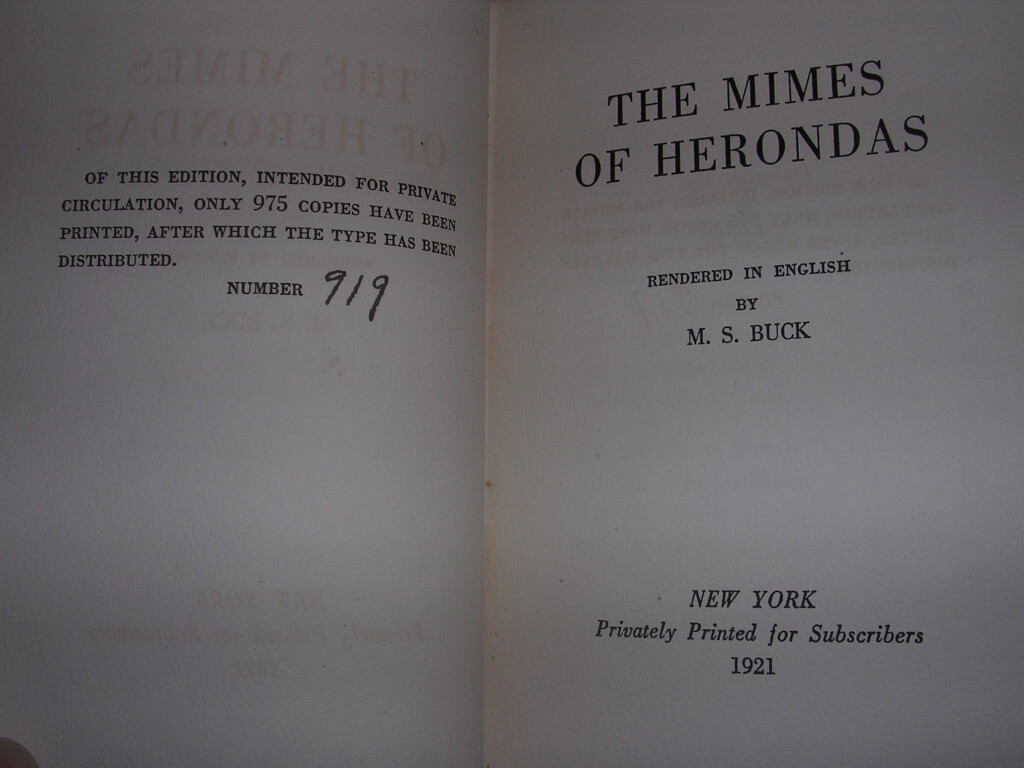
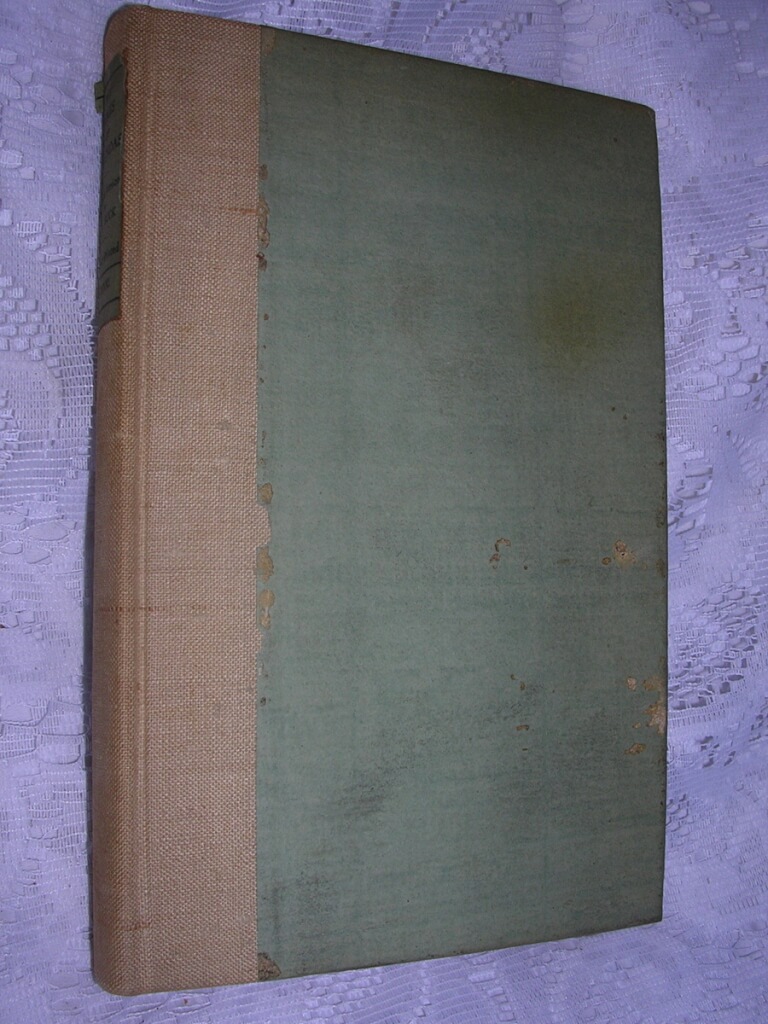 The Mimes of Herondas, trans. M. S. Buck (Privately Printed for Subscribers, New York, 1921, #70/975) 7" X 4 5/8", 119pp, hardbound no DJ, paper boards with beige cloth spine, top edge gilt, others deckle, good condition, lightly soiled Herodas was a Greek poet and the author of short humorous dramatic scenes in verse, written under the Alexandrian empire in the 3rd century BC. Mimes were scenes in popular life in South Italy and Sicily, written in the language of the people, vigorous with racy proverbs such as we get in other reflections of that region. The Mimes of Herodas have been known to us only since the discovery and publication of the "Kenyon", M. S. Buck, by the British Museum in 1891 (from a parchment containing 7 legible mimes half of the 8th and a fragment of the 9th).
The Mimes of Herondas, trans. M. S. Buck (Privately Printed for Subscribers, New York, 1921, #70/975) 7" X 4 5/8", 119pp, hardbound no DJ, paper boards with beige cloth spine, top edge gilt, others deckle, good condition, lightly soiled Herodas was a Greek poet and the author of short humorous dramatic scenes in verse, written under the Alexandrian empire in the 3rd century BC. Mimes were scenes in popular life in South Italy and Sicily, written in the language of the people, vigorous with racy proverbs such as we get in other reflections of that region. The Mimes of Herodas have been known to us only since the discovery and publication of the "Kenyon", M. S. Buck, by the British Museum in 1891 (from a parchment containing 7 legible mimes half of the 8th and a fragment of the 9th). -
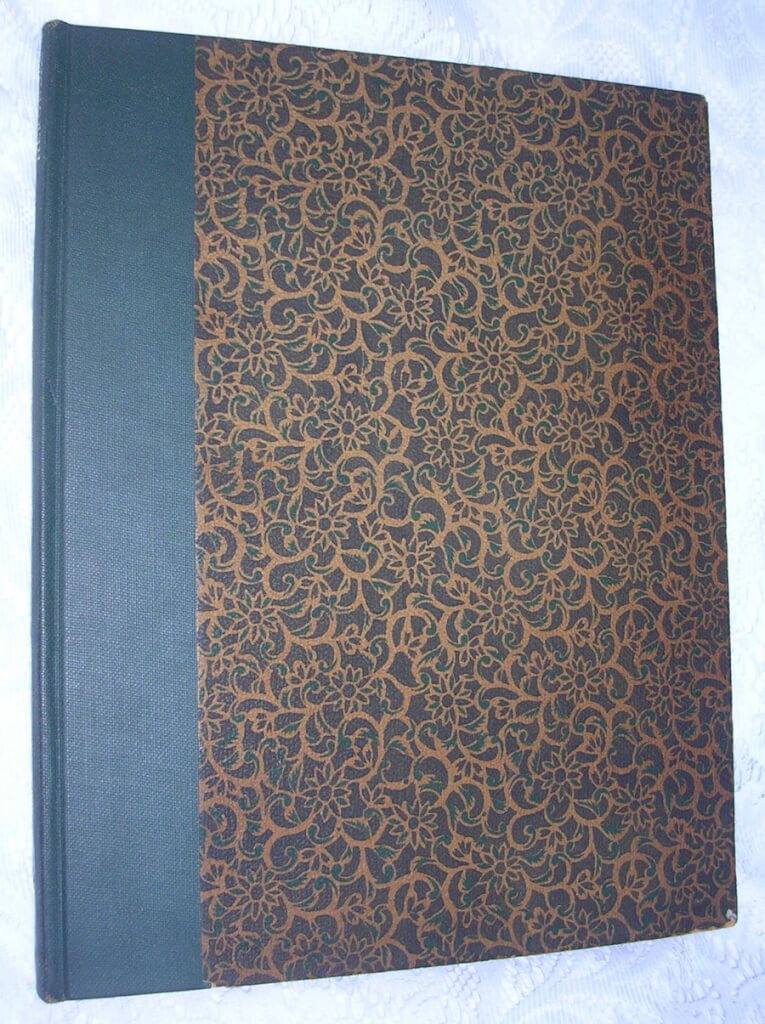
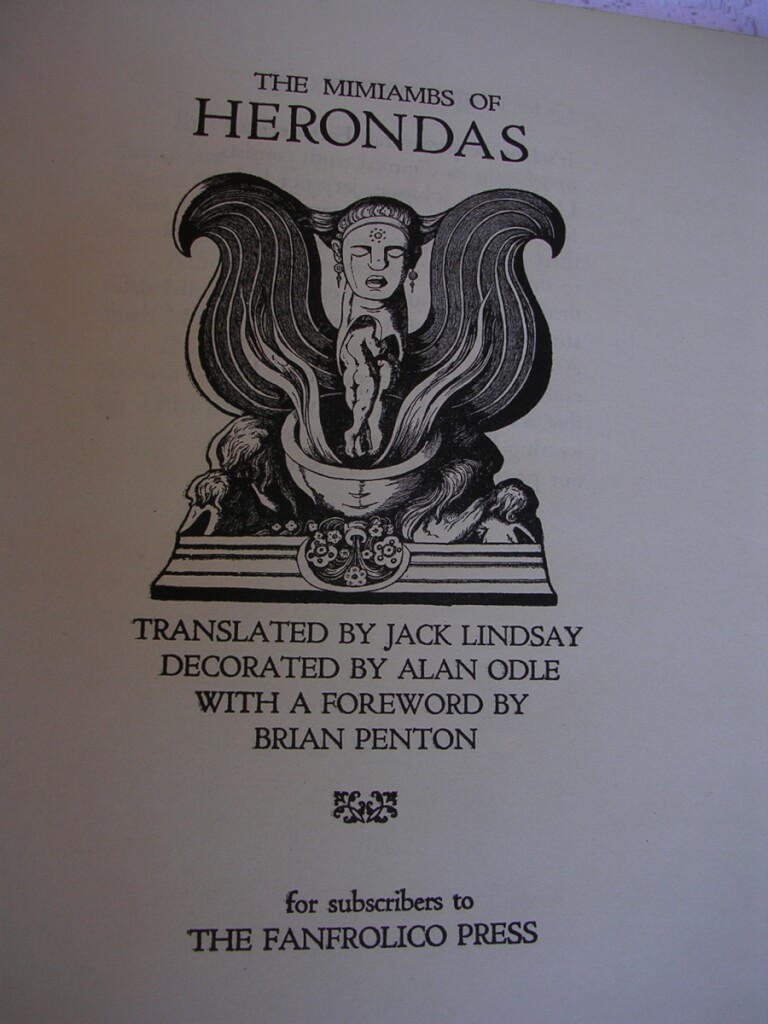 The Mimiambs of Herondas, Herodas, Translated by Jack Lindsay, Decorated by Alan Odle, with a Foreword by Brian Penton. (The Fanfrolico Press, London, nd [c. 1929], #106/375 [first edition, and first Fanfrolico to be printed in London]) 11 7/8" X 9 3/8", unpaginated 72pp, hardbound no DJ, original buckram-backed decorated Japanese paper boards with plain green cloth spine and gilt lettering, top edge gilt, other edges deckle, very good condition minor wear to bottom of boards, Cloister types on Van Gelder Antique handmade paper Herodas was a Greek poet and the author of short humorous dramatic scenes in verse, written under the Alexandrian empire in the 3rd century BC. Mimes were scenes in popular life in South Italy and Sicily, written in the language of the people, vigorous with racy proverbs such as we get in other reflections of that region. The Mimes of Herodas have been known to us only since the discovery and publication of the "Kenyon", M. S. Buck, by the British Museum in 1891 (from a parchment containing 7 legible mimes half of the 8th and a fragment of the 9th). This was Fanfrolico's first London book. It was published "for subscribers to The Franfrolico Press". This new translation of Mimiambs of Herondas was translated by Jack Lindsay and beautifully illustrated by Alan Odle whose grotesque and subversive style was a precursor of surrealism. This is a beautiful printed book in great condition and quite rare. Fanfrolico Press, Australia’s first ‘private press’ in the arts-and-craft tradition, was founded by Jack Lindsay, P. R. Stephensen and John Kirtley, originally in North Sydney in 1923. The press specialized in printings artful, limited editions of classics and forgotten works that were suited to the extravagant style of artist like his father, artist, sculptor and author Norman Lindsay who illustrated many of their books. Fanfrolico was scornful of modernism and with its florid style determinedly backward-looking. They did surprisingly well, despite the lack of business expertise of their young, ambitious "bohemian" owners, eking out a living despite the risky move to London in 1926 and upheavals in ownership that saw the departure in 1927 of Kirtley, and then Stephenson in 1929. Sometime in 1930 they published their last book.
The Mimiambs of Herondas, Herodas, Translated by Jack Lindsay, Decorated by Alan Odle, with a Foreword by Brian Penton. (The Fanfrolico Press, London, nd [c. 1929], #106/375 [first edition, and first Fanfrolico to be printed in London]) 11 7/8" X 9 3/8", unpaginated 72pp, hardbound no DJ, original buckram-backed decorated Japanese paper boards with plain green cloth spine and gilt lettering, top edge gilt, other edges deckle, very good condition minor wear to bottom of boards, Cloister types on Van Gelder Antique handmade paper Herodas was a Greek poet and the author of short humorous dramatic scenes in verse, written under the Alexandrian empire in the 3rd century BC. Mimes were scenes in popular life in South Italy and Sicily, written in the language of the people, vigorous with racy proverbs such as we get in other reflections of that region. The Mimes of Herodas have been known to us only since the discovery and publication of the "Kenyon", M. S. Buck, by the British Museum in 1891 (from a parchment containing 7 legible mimes half of the 8th and a fragment of the 9th). This was Fanfrolico's first London book. It was published "for subscribers to The Franfrolico Press". This new translation of Mimiambs of Herondas was translated by Jack Lindsay and beautifully illustrated by Alan Odle whose grotesque and subversive style was a precursor of surrealism. This is a beautiful printed book in great condition and quite rare. Fanfrolico Press, Australia’s first ‘private press’ in the arts-and-craft tradition, was founded by Jack Lindsay, P. R. Stephensen and John Kirtley, originally in North Sydney in 1923. The press specialized in printings artful, limited editions of classics and forgotten works that were suited to the extravagant style of artist like his father, artist, sculptor and author Norman Lindsay who illustrated many of their books. Fanfrolico was scornful of modernism and with its florid style determinedly backward-looking. They did surprisingly well, despite the lack of business expertise of their young, ambitious "bohemian" owners, eking out a living despite the risky move to London in 1926 and upheavals in ownership that saw the departure in 1927 of Kirtley, and then Stephenson in 1929. Sometime in 1930 they published their last book.
